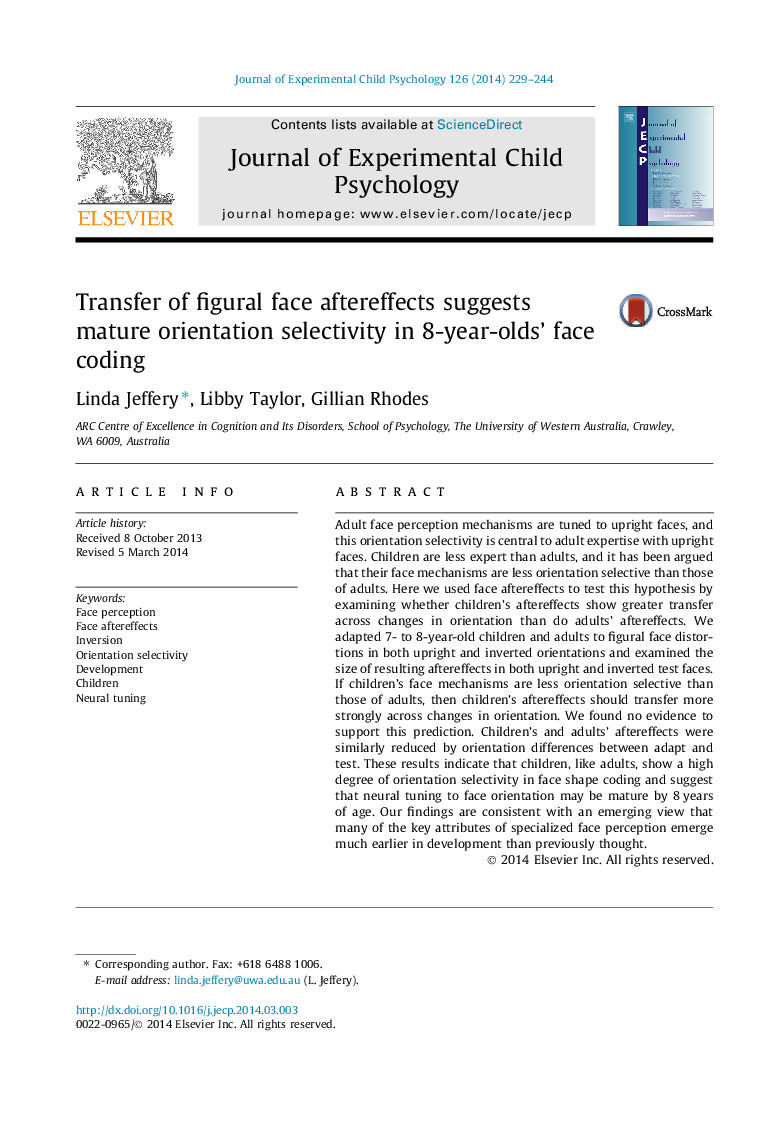| کد مقاله | کد نشریه | سال انتشار | مقاله انگلیسی | نسخه تمام متن |
|---|---|---|---|---|
| 7275382 | 1473486 | 2014 | 16 صفحه PDF | دانلود رایگان |
عنوان انگلیسی مقاله ISI
Transfer of figural face aftereffects suggests mature orientation selectivity in 8-year-olds' face coding
ترجمه فارسی عنوان
انتقال عوارض چهره شکل دهنده انتخاب گرایش بالغ در برنامه چهره 8 ساله است
دانلود مقاله + سفارش ترجمه
دانلود مقاله ISI انگلیسی
رایگان برای ایرانیان
کلمات کلیدی
ادراک چهره، اثرات چهره، اینورتر، گزینشی جهت توسعه، فرزندان، تنظیم عصبی،
ترجمه چکیده
مکانیسم های ادراک چهره بزرگسالان به چهره های راست تنظیم شده است، و این انتخاب گرایش متمرکز است برای تخصص بالایی با چهره های راست. کودکان متخصص کمتر از بزرگسالان هستند و استدلال شده است که مکانیسم چهره آنها گزینشی کمتر نسبت به بزرگسالان است. در اینجا، پس از اثرات چهره برای تست این فرضیه، با بررسی اینکه آیا پیامدهای فرزند بیشتر در تغییرات جهت گیری بیشتر از اثرات بزرگسالان است. ما کودکان و بزرگسالان 7-8 ساله را به اعوجاج شکل چهره در هر دو جهت راست و معکوس تطبیق دادیم و اندازه عواقب ناشی از آن را در چهره های آزمایش راست و چپ باز بررسی کردیم. اگر مکانیزم های صورت چهره کمتر گرایش انتخابی نسبت به بزرگسالان داشته باشند، پس از آن کودکان باید بیشتر به تغییرات در جهت گیری انتقال داده شوند. ما هیچ شواهدی را برای پشتیبانی از این پیش بینی یافتیم. اثرات کودکان و بزرگسالان به طور مشابه با تغییر جهت گیری بین انطباق و آزمون کاهش می یابد. این نتایج نشان می دهد که کودکان مانند بزرگسالان میزان انتخاب انتخاب گرایش را در کدگذاری شکل چهره نشان می دهند و پیشنهاد می کنند که تنظیم عصبی جهت مواجه شدن با چهره ممکن است با سن 8 سالگی به سن بلوغ برسد. یافته های ما مطابق با دیدگاه ظاهری است که بسیاری از ویژگی های کلیدی تصور چهره تخصصی، بسیار پیش از آن در حال توسعه هستند، که قبلا تصور می شد.
موضوعات مرتبط
علوم انسانی و اجتماعی
روانشناسی
روانشناسی رشد و آموزشی
چکیده انگلیسی
Adult face perception mechanisms are tuned to upright faces, and this orientation selectivity is central to adult expertise with upright faces. Children are less expert than adults, and it has been argued that their face mechanisms are less orientation selective than those of adults. Here we used face aftereffects to test this hypothesis by examining whether children's aftereffects show greater transfer across changes in orientation than do adults' aftereffects. We adapted 7- to 8-year-old children and adults to figural face distortions in both upright and inverted orientations and examined the size of resulting aftereffects in both upright and inverted test faces. If children's face mechanisms are less orientation selective than those of adults, then children's aftereffects should transfer more strongly across changes in orientation. We found no evidence to support this prediction. Children's and adults' aftereffects were similarly reduced by orientation differences between adapt and test. These results indicate that children, like adults, show a high degree of orientation selectivity in face shape coding and suggest that neural tuning to face orientation may be mature by 8Â years of age. Our findings are consistent with an emerging view that many of the key attributes of specialized face perception emerge much earlier in development than previously thought.
ناشر
Database: Elsevier - ScienceDirect (ساینس دایرکت)
Journal: Journal of Experimental Child Psychology - Volume 126, October 2014, Pages 229-244
Journal: Journal of Experimental Child Psychology - Volume 126, October 2014, Pages 229-244
نویسندگان
Linda Jeffery, Libby Taylor, Gillian Rhodes,
